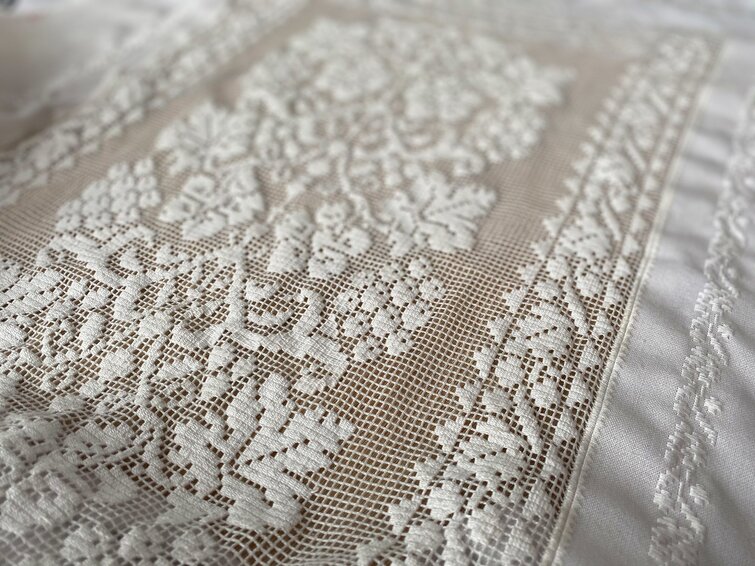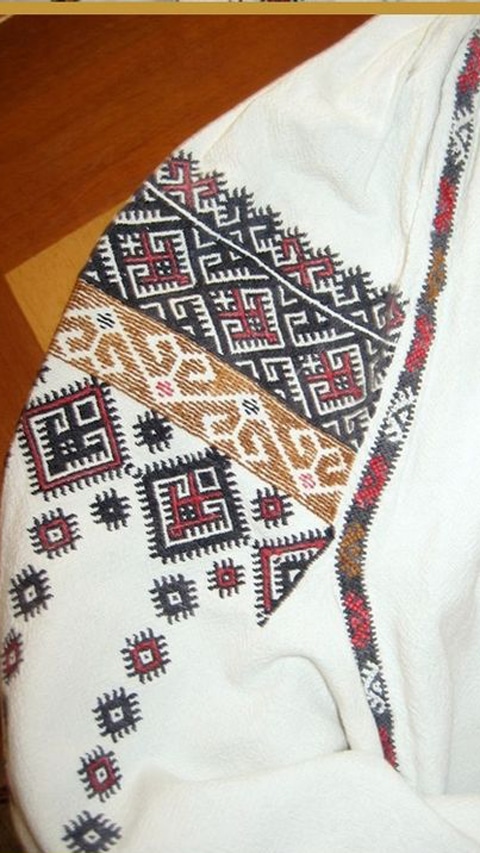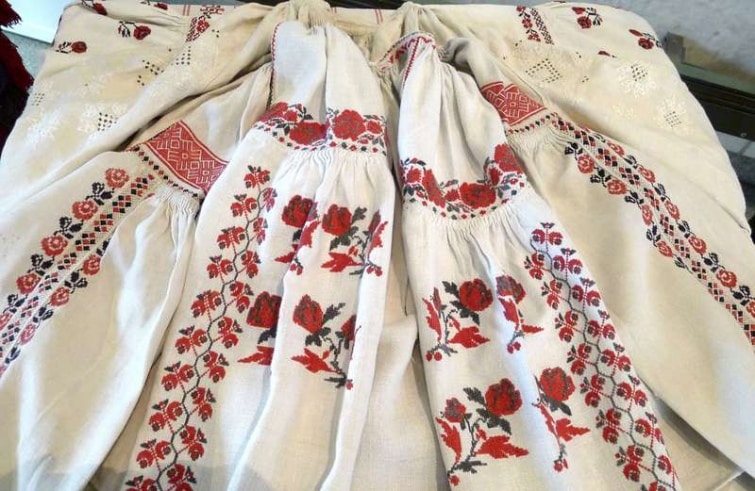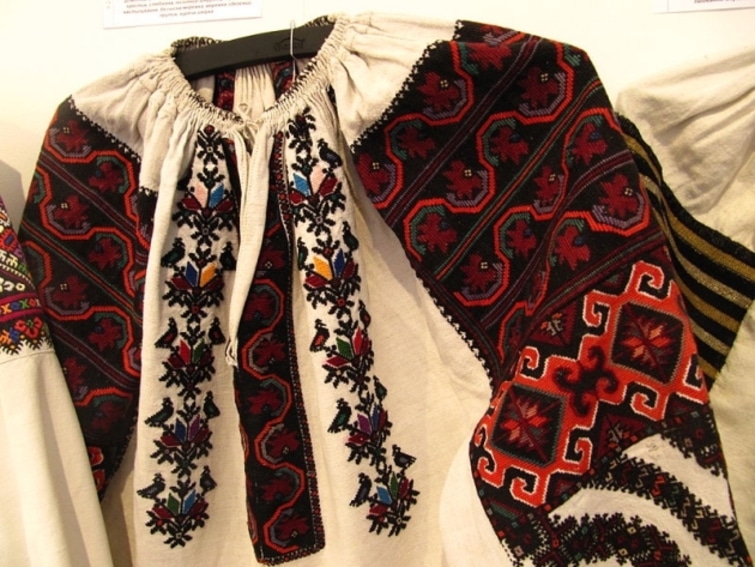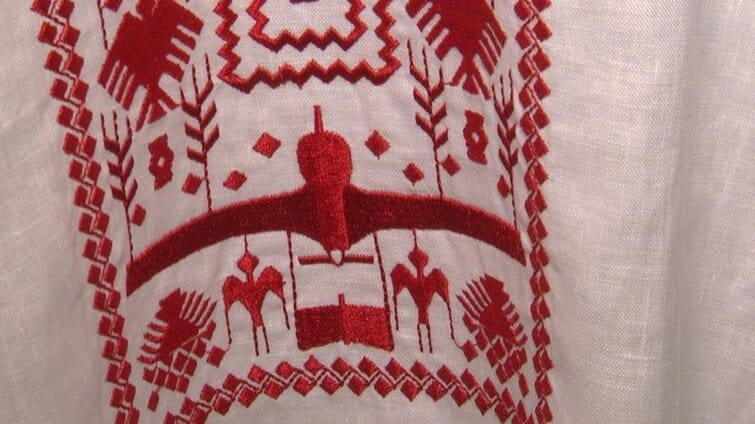Table of Contents
Every year on the third Thursday of May, Ukrainians traditionally wear embroidered shirts called “vyshyvanky”. This year, Vyshyvanka Day falls on May 18.
The embroidered shirt has changed its place in the wardrobe from casual clothes to the most elegant ones. Ukrainska Pravda (Ukrainian news website) talked to Lesia Voroniuk, one of the founders of the holiday, Khrystyna Dukh-Zafiyovska, an artist, and Halyna Yatsentiuk, a folklore collector and owner of the Vyshyvanka Museum in Verkhovyna, about the history of the holiday, the importance of embroidery as a talisman, and modern ornaments.
Establishment of the Vyshyvanka Day
In 2006, five students from the History Faculty of Chernivtsi University wore vyshyvanky (embroidered shirts).
“At that time, t-shirts with DiCaprio and Titanic were trendy, not vyshyvanky. Only the well-performing students wore them,” recalls Lesia Voroniuk, one of the founders of the holiday, with a smile.
At that time, the initiative was supported by dozens of students in Chernivtsi. Wearing a vyshyvanka was considered “unfashionable,” so changing that perception was quite an achievement.
“I remember the first Vyshyvanka Day very well when I enter the History Faculty wearing an embroidered shirt and look for other people who have also joined the initiative. I walk on the first floor, and I don’t see anyone. I go up the stairs, and there’s one person in a shirt, another one, and another one. Now I understand that it was such a bold and daring decision because back then it was even considered somewhat of an “anti-trend,” shares Lesia Voroniuk.
Nowadays, the significance of the vyshyvanka has changed dramatically. Just like over 100 years ago, it has become a sacred talisman for Ukrainians.
“The vyshyvanka is embroidered to protect. Once, it was a kind of talisman, especially for children. Now it is a talisman for all Ukrainians,” emphasizes Halyna Yatsentiuk.
“Today, when Vyshyvanka Day is 17 years old, and there is a war outside, the embroidered shirt is a spiritual armor for me. I believe it is the most expressive and clear definition of its significance,” adds the co-founder of the holiday.
Such significance of the vyshyvanka emerged after the 2000s. From being considered “unfashionable,” it has become one of the main guardians of Ukrainian culture in the era of independence. Lesia Voroniuk timidly agrees that the establishment of Vyshyvanka Day could have contributed to this as well.
“It [the holiday – ed.] emerged on one hand, perhaps by chance, and on the other hand, probably by necessity. By chance, when one day I saw my friend Ihor Zhytaryuk wearing an embroidered shirt during a break at the university. He would occasionally wear it, and one of our friends suggested choosing a day to gather and be in embroidered shirts together. At that time, only a few dozen students supported this initiative, but that’s how the holiday was born. On the other hand, perhaps this idea was developed by necessity. Because I was born into an artistic family. It’s a family that never succumbed to the regime of Soviet occupation and ideology. It’s a family where Ukrainian identity was always preserved,” tells Lesia Voroniuk.
Going beyond the borders of Ukraine
The co-founders of Vyshyvanka Day sent hundreds of letters to government agencies, requesting support for students in establishing the holiday. And they succeeded. Vyshyvanka Day is now celebrated in over 100 countries around the world, not only by Ukrainians. Ukrainian embroidered shirts are presented to presidents of other countries, officials, and celebrities. The latter proudly wear them as a symbol of solidarity with Ukraine.
However, the vyshyvanka is not just beautiful clothing. It represents Ukrainian identity. Ancient embroideries are artistic works that distinguish Ukraine from other nations.
“The vyshyvanka should be in the soul so that a person doesn’t feel indifferent. If it doesn’t resonate in a person’s soul, there’s nothing to wear on the body. In the past three years, I’ve had so many people purchase embroidered shirts that I can’t even count. Especially many internally displaced persons who have moved to our area want to buy them because they say they never had them before. You should see how a person at the age of 45 puts on a vyshyvanka for the first time. People are drawn to it for the holiday, which is why it is needed,” confidently states Halyna Yatsentiuk.
What do the patterns and ornaments on the vyshyvanka mean?
Each Ukrainian region has its own ornaments and embroidery techniques, says Halyna Yatsentiuk.
For example, in Hutsulshchyna, the embroidery was done on a black background. As the craftswomen would say, the black color reflected negative thoughts. Each embroidered symbol had its own meaning. The placement, colors, and ornaments were meticulously thought out down to the smallest details.
Northern regions
In the northern regions, artists preferred both geometric and floral ornaments.
Grapes, symbolizing family, and viburnum, representing Ukrainian spirituality, were depicted on the shirts. Later, hops, which celebrated youthful energy and love, were also embroidered.
Black and red colors were predominantly used. Geometric figures served as protective elements in the embroidery. Shirts from the Sumy region also featured depictions of birds such as eagles, swans, or doves.
In the Poltava region, embroidery is done with white threads on white fabric. In 2017-2018, the embroidery technique known as “white-on-white” from the Poltava region was included in the National List of Intangible Cultural Heritage, and this year it may be added to the UNESCO Representative List of the Intangible Cultural Heritage of Humanity.
Source: Ukrainska Pravda
In the folk tradition, this technique is associated with the beauty of frosty patterns that inspired the artists when they developed this embroidery technique.
Southern Ukraine and Crimea
The vyshyvankas in Crimea significantly differed from the rest. It combined Ukrainian culture with the heritage of Turkic peoples.
Crimean shirts were also characterized by a contrast of colors. Floral motifs prevailed, where each flower held a special meaning. They were chosen according to age and gender: roses for young girls, tulips for boys, and carnations were embroidered on the clothes of older individuals.
Source: Roman Skvoriy Museum of Bolekhiv History
In other southern regions, plant motifs were also prominent but intertwined with geometric ornaments. A distinctive feature of vyshyvanka from the Odesa region is the “pukhlyk” — a gathered fabric on the sleeve, situated below the shoulder, which adds richness and volume to the garment.
Eastern regions
The vyshyvanka from Luhansk and Donetsk regions featured lush flowers and trees, symbolizing life. The shirts were adorned with meshwork and used thick threads to add texture. Birds were depicted on wedding towels as a symbol of enchantment and magic.
Source: Roman Skvoriy Museum of Bolekhiv History
The artists combined contrasting vibrant colors and various embroidery techniques, although cross-stitch was most commonly used.
Western Ukraine
Vyshyvanka from the western regions was characterized by dense and lavish embroidery. In Zakarpattia, it was not uncommon to combine up to ten colors in a single shirt.
See also: A source of non-knowledge: the history of Ukraine in European school textbooks
The main figures included the diamond shape, adorned with other elements, and the so-called “kryvulky” (zigzags).
Source: Ivan Honchar Museum
Ternopil embroidery is characterized by lush and densely packed ornamentation on the sleeves. The patterns are clear, contrasting, and often feature three-dimensional elements. Similar elements can also be found in Bukovyna. Here, geometric ornaments are combined with vibrant and large flowers. Despite the abundance of floral motifs, predominantly one color is used for the embroidery in the regions: black, red, blue, or white. Silver and gold threads, beads, silk, wool, and metallic sequins were even used in the embroidery.
In the Lviv region, the embroideries are predominantly executed using cross-stitch and stem stitch, resembling delicate lacework. They feature intricate webs of small black flowers, combined with red, yellow, green, and blue elements.
Embroidered shirts with Bayraktars
Currently, there is an increasing trend of machine embroidery with various patterns that do not resemble the symbols of traditional Ukrainian embroidery. However, according to Halyna Yatsentiuk, the most important thing is the individual’s desire to wear an embroidered shirt, regardless of the design depicted on it.
“We need to understand that embroidered shirts are a very broad and expansive concept today. It is important not to confuse the meanings when we talk about artistic value. We may evaluate embroidered shirts based on their quality, for example. However, when we discuss identity and ideology, the main value is that as a society, we have matured to wear and perceive Ukrainian embroidered shirts. Furthermore, at one time, we used to send shirts to Ukrainian political prisoners in Russia and to Ukrainian soldiers fighting. The most important thing was that they received an embroidered shirt. Whether it was hand-embroidered or machine-embroidered, it didn’t matter,” says Lesya Voroniuk.
Source: Suspilne.ua
Green embroidered shirts with Bayraktar drones and airplanes are becoming increasingly popular, emphasizes Halyna Yatsentiuk.
“A green embroidered shirt inspires action. Action to protect. I had two military personnel from the Sumy region who bought green embroidered shirts. They wear green because they serve, but still want embroidered shirts and celebrate the holiday,” she tells.
The embroidered shirt evolves along with society, says artist Khrystyna Dukh-Zafiyovska.
“Embroidery has always evolved. Fabrics and threads changed, and new techniques emerged, shaping the style. Even within a span of 20 years, embroidery in one region could undergo transformations,” she emphasizes.
Ukrainians reflect what is happening to them through symbols and sacred objects. Everything they feel, experience, or visualize is primarily conveyed through embroidered shirts, towels, and Easter eggs.
“Embroidered shirt is functional clothing, first and foremost, it was meant to be practical and beautiful. The patterns were created by people, and this should be remembered. They were influenced by the environment, nature, people, and climate. In the Soviet Union, for example, artists concealed tridents, colors, and Ukrainian symbols in their embroideries,” emphasizes Khrystyna Dukh-Zafiyovska.
According to the artist, contemporary embroidery with depictions of planes and tanks will not become symbolic or preserved in the history of Ukrainian embroidery. However, it exists today because it is important for Ukrainians and preserves the memory of what we have experienced.
Why isn’t Vyshyvanka Day an official state holiday?
“We tried to make it so,” shares the co-founder of the World Vyshyvanka Day.
However, a few years ago, the initiative was not supported at the state level. Now, Lesya Voroniuk believes that it is for the better. According to her, an official holiday comes with obligations, while a grassroots movement encourages people to feel and love it.
“In private companies, a corporate culture has emerged: wearing an embroidered shirt on this day. And it’s not mandatory for them. It’s not even educational or cultural institutions or administrations where it’s required. Enterprises invite us to various lectures to talk about embroidered shirts before the holiday. I have two or three meetings like this every day with such groups. It seems to me that this is just a wonderful example of how civil society works,” concludes Lesya Voroniuk.
Originally posted by Anastasia Koropetska on Ukrainska Pravda life. Translated and edited by the UaPosition – Ukrainian news and analytics website
See also: How Ukrainian museums survive during the great war

